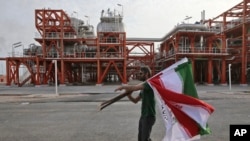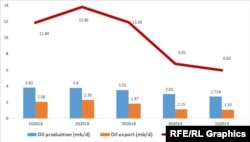The U.S. ended exemptions offered to some Iranian oil importers on April 22, aiming for zero Iranian oil exports. But the real question is what would be the financial impact on Iran?
The country mainly depends on oil revenues which constitute around 40% of the government’s current budget. Last Iranian fiscal year, the share of oil export revenues in the budget was 33.3%.
Since there are three different currency exchange rates in Iran, it is difficult to exactly say how much of the budget depends on dollar revenues from oil, but the total amount from exports gives a pretty good indication of Iran’s dependence on fossil fuel income.
According to Iran’s Parliament Research Center’s estimates, the current budget has projected exporting 1.54 million barrels per day of crude oil and gas condensate at $54.1/barrel, though the price for Iranian oil is expected to stand above $65 in 2019.
Therefore, Iran has planned to earn about $30.4 billion from oil and gas condensate export, of which about $24 billion goes to government’s operating budget and the National Iranian Oil Company, and the rest is supposed to be deposited into the National Development Fund (NDF); Iran’s savings’ plan for future generations.
The Parliament Research Center has put the USD exchange rate at about 60,000 rials in its calculations.
Now, with U.S. aiming to bring Iran’s oil exports down to zero, how can the government, facing an economic crisis, high unemployment and inflation pay its bills?
The simple answer is, there is no way for Iran to climb out of this abyss. The budget’s share from oil export revenues ($24 billion) equals the government’s total payments to about 4.6 million employees, pensionaries and some non-governmental workers in the current fiscal year. This imply means the government cannot meet its payroll and this will leave about 18 million citizens without income, if we suppose that each one of the 4.6 million people who depend on government checks support another three family members.
Source: a combination of OPEC, tanker trackers, Reuters, Forbes, Bloomberg statistics
Iran’s gas condensate exports during March 2018 to March 2019 also stood at about 220,000 b/d worth $4.95bn, which indicate a 45% decline in volume and 30% decline in value year-on-year.
According to tanker tracking companies, Iran has also exported 0.1 to 0.3 mb/d oil secretly, using various indirect methods, but this is too little to make a difference in the government’s cash flow situation.
Hard currency reserves
Iran’s foreign assets basket includes various currencies, including USD, euro, yuan, yen, etc, but Iran cannot receive any payments in USD from abroad due to U.S. sanctions.
According to the International Monetary Fund’s estimation, Iran’s hard currency reserves were about $100 billion in early 2017, when it was free of oil sanctions and was exporting as much as it could.
However, Senior Research Consultant Mehrdad Emadi at UK-based Betamatrix told Radio Farda that according to documents, Iran’s total foreign currency reserves in January 2017 was equivalent to about $124 billion, but it decreased to about 70 billion in July 2018. During the second half of 2018, Iran spent about $6 billion to develop military defense projects as well as further $3.5 billion to engage in re-construction projects in Syria. “Its foreign currency assets stood at $58 billion at the end of 2018, of which $47 billion was outside of Iran, mostly in China, India and Russia and $11 in Iran.
Regarding reserves actually held in U.S. dollars, Emadi believes Iran has $35 billion. This is a potential problem, because any funds held abroad in U.S. currency cannot be repatriated to Iran as a result of sanctions.
The main reason for the decrease in Iran’s reserves is dwindling export revenues since U.S. sanctions were reimposed. This has forced Iran to defend its currency by dumping some dollars in the local market. It has also forced Tehran to draw on its reserves to keep the economy form a total collapse.
Non-oil exports
Iran’s non-oil exports (Iran includes gas condensate in non-oil exports basket) declined 6% year-on-year last Iranian fiscal year to $44.31 billion, while before the reimposition of sanctions (March 22-August 21, 2018) it had grown 13% year-on-year.
Iran also imported $42.6 billion worth of commodities during last fiscal year, which indicates a 20% decline year-on-year.
Therefore, alongside oil export plunge, both Iran’s non-oil exports and its imports show a clear declining trend, affected by U.S. sanctions.







